Welcome to Sandy Bridge, with the ASRock P67 Extreme4
by Ian Cutress on January 3, 2011 7:00 AM EST- Posted in
- Motherboards
- ASRock
System Benchmarks
CrystalDiskMark 3.0.1
We test the motherboard's USB 2.0 and USB 3.0 speed via CrystalDiskMark. We run the sequential test to find the optimum read/write speed, then perform a copy from the SSD to the USB device. We copy a set of 2867 files across 320 folders—95% of these files are small typical website files, and the rest (90% of the size) are the videos used in the Sorenson Squeeze test. Total size is 1.52GB
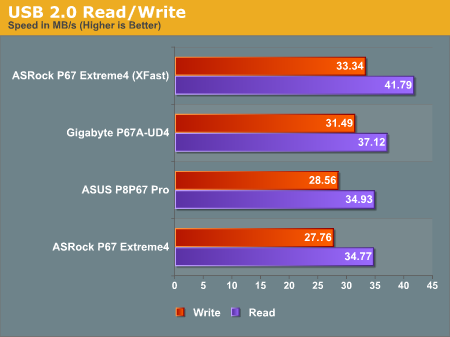
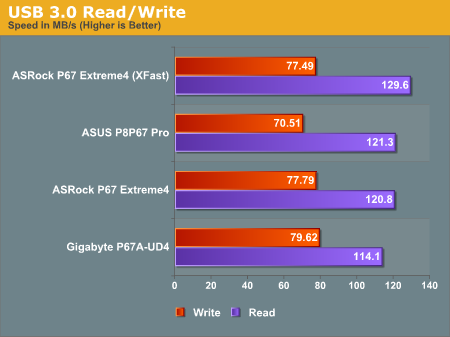

We also tested the ASRock XFast USB software. While making a slight difference to the sequential read/write speeds, it actually makes a difference in real-world situations where large amounts of small files need to be copied. USB 3.0 didn't benefit as much as USB 2.0, and it's worth noting that without XFast the USB 2.0 speed was the slowest of the three motherboards, but it does provide a benefit and turns the Extreme4 into the fastest overall USB choice.
3D Movement Algorithm Test
This benchmark is actually one I have written. My full time job involves computational chemistry, so this first benchmark uses various algorithms for three-dimensional simulation and movement of independent particles. The algorithms either employ uniform random number generation or normal distribution random number generation (with periods exceeding 2^120), and vary in various amounts of trigonometric operations, conditional statements, generation and rejection, fused operations, etc. The benchmark runs through six algorithms for a specified number of particles and steps, and calculates the speed of each algorithm, then sums them all for a final score. This is an example of a real world situation that a computational scientist may find themselves in, rather than a pure synthetic benchmark. The benchmark is also parallel between particles simulated, and we test the single thread performance as well as the multi-threaded performance.

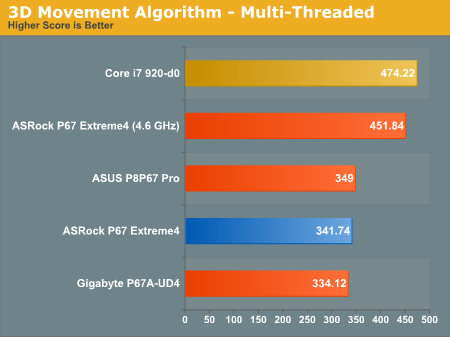
As expected, the single thread performance with the Sandy Bridge processor over the i7-920. This is in part due to the difference in speed in single-thread mode, but also to the increased logic on the Sandy Bridge processor. In the multi-threaded test, it's a case of available threads - the i5-2500K has 4 cores/4 threads available, whereas the i7-920 has 4 cores/8 threads available. In both tests, the ASRock performs well, being beaten (just) by the P8P67 Pro.
With 64-bit WinRAR, we compress a set of 2867 files across 320 folders—95% of these files are small typical website files, and the rest (90% of the size) are the videos used in the Sorenson Squeeze test. Total size is 1.52GB. WinRAR x64 3.93 attempts to use multithreading when possible.
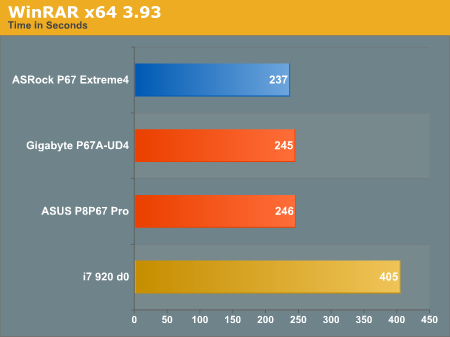
FastStone Image Viewer 4.2
FastStone Image Viewer is a free piece of software I have been using for quite a few years now. It allows quick viewing of flat images, as well as resizing, changing color depth, adding simple text or simple filters. It also has a bulk image conversion tool, which we use here. The software currently operates only in single-threaded mode, which should change in later versions of the software. For this test, we convert a series of 170 files, of various resolutions, dimensions and types (of a total size of 163MB), all to the .gif format of 640x480 dimensions.
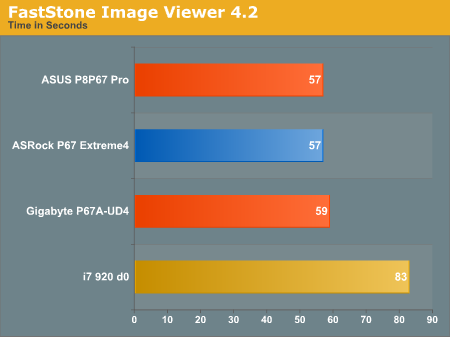
Sorenson Squeeze 6.0
Sorenson Squeeze is a professional video encoder, complete and rife with options. For this test, we convert 33 HD videos, each a minute long and approximately 42 MB in size, to WMV 512KBps format. Squeeze can encode multiple videos at once, one for each thread.
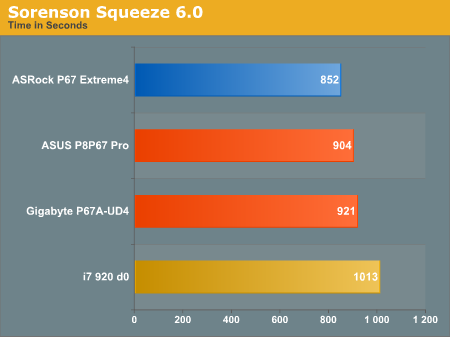
Overview
The ASRock board has relatively mediocre USB speeds, until XFast is used. In general, this board does fairly well across the entire 2D benchmark suite, either being at the top or near the top.










55 Comments
View All Comments
GTVic - Monday, January 3, 2011 - link
On page 3 there is a BIOS version listed?cmdrdredd - Monday, January 3, 2011 - link
no SATA 6Gbps, only two 8x PCIe lanes not two 16x, and it's generally low end.IanCutress - Wednesday, January 5, 2011 - link
The PCIe bandwidth for P67 is double that of P55/X58, so an 8x here is equivalent to an old 16x. A lot of people gloss over this fact, similar to wondering why the 6xxx cards have less SPs than 5xxx counterparts - it's an architectural change.Ian
drvelocity - Monday, January 3, 2011 - link
Why was the ASUS p8p67 getting spanked so hard in the single GPU tests? Any insight on that?Spivonious - Tuesday, January 4, 2011 - link
Please stop stating that mouse use is something new. I could use the mouse in the BIOS setup of my Tyan 440BX motherboard in 1998.Also, you state that you prefer two ethernet ports but never explain why. Unless you're using the computer as a gateway, why do you need more than one?
IanCutress - Wednesday, January 5, 2011 - link
We never state that using a mouse is something new. We state it's an improvement or a major benefit over the majority of previous BIOS implementations, especially in the last ten years of mainstream computing and to most consumers.In terms of dual Ethernet ports, there are many options:
1) Link Aggregation
2) Large format printers/plotters
3) Various file/server systems require a second NIC for metadata
It's true 99.99% of people won't need it, but for the low price of the chip, it's not too much to ask. Ideally, we'd want the Intel NIC every time - it's more configurable.
Ian
Spivonious - Wednesday, January 5, 2011 - link
"Major benefits include a graphical interface, the ability to use a mouse..."Maybe you didn't mean to, but it definitely implies that these things are new with UEFI.
1) Gigabit switches are under $30. The average broadband connection is well under 100Mbps. There is also very limited support for link aggregation in consumer-level products.
2) Yeah, let me pull that one out of the closet. Again, P67 is targeted at home users.
3) Can you name a few? And again, the average home user might have a simple file/media server.
I would be surprised if the next X series boards don't feature dual ethernet ports, but to mention it more than once on a board targeted towards the midrange is more than a bit silly.
IanCutress - Saturday, January 8, 2011 - link
P67 may be targeted at home users, but industry will look at it as well as a viable option, regardless of where it's targeted. It's easy to get roped into a home-users own little world when that's the only thing that maybe important to you. As a reviewer, it's important not to overlook that fact.The point we make is that it is easy enough for a manufacturer to increase the range of appeal of the hardware, by adding a small hardware element for which there is space. If you read through recent Anandtech motherboard reviews, there is a trend for industry level readers to take note of various products we review and add comments on the benefits/drawbacks certain products have for their line of industry, regardless of where the board is actually aimed for. This is why we cover things like dual Ethernet in reviews.
Ian
mapesdhs - Wednesday, January 5, 2011 - link
I could use a mouse for my SGI's equivalent setup in 1992. :D
Ian.
ibudic1 - Tuesday, January 4, 2011 - link
Thank you for posting your benchmark. We do 3D rendering, and some 3D computation (planned), and your benchmark makes sense for us.If I were to produce a benchmark for you to test would you be interested?